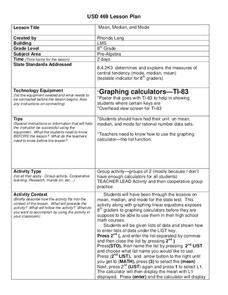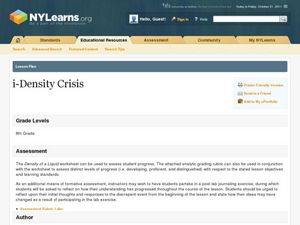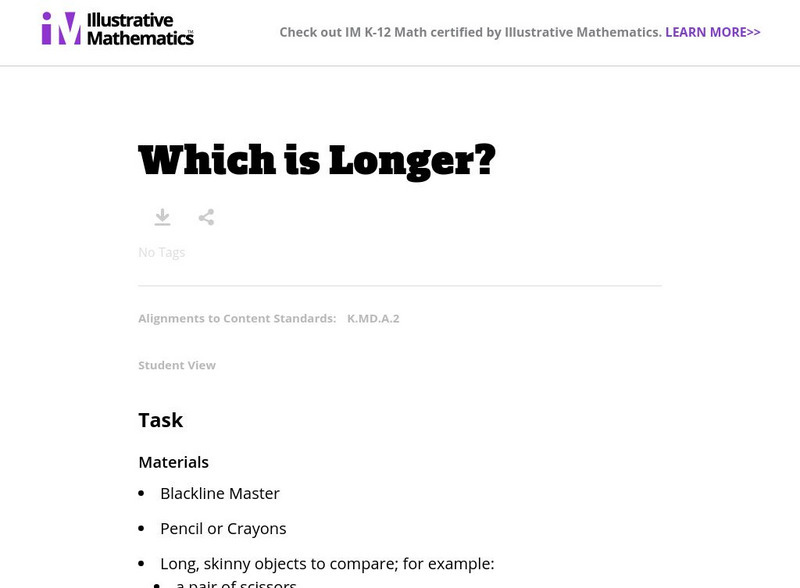Curated OER
You say Avocado, I say Avogadro
Students convert mole to mass to particles and vice versa. In this chemistry lesson, students discuss the importance of Avogadro's number. They apply what they have learned in a team competition.
Curated OER
Calculating the Average Mass of the Newly Discovered Element: Bean
Students determine the average mass of a new element using masses from three isotopes. In this chemistry lesson, students explain what an isotope is. They discuss their importance and uses.
Curated OER
Discovering The Oasis
Students participate in a lesson that is concerned with the ecosystem of a local pond. The teacher makes arrangements for students to take a field trip. Time is spent in class for preparation and afterward for debriefing of lab...
Curated OER
Acid Rain
Middle schoolers identify the causes and effects of acid rain. Using the internet, they research pollution sources in their local area and by collecting rain samples and testing the pH. In groups, they develop their own plan urging...
Curated OER
Geography of Early China
Students research and identify the primary geographic features of China. They investigate which features isolated China, and identify the significance of the Hwang River to Early Chinese civilizations. Finally, they research the Silk...
Curated OER
Zhou Dynasty
Students research the contributions of the Zho Dynasty. They identify the Mandate of Heaven, and the growth of the economy under the Zhou. They research the history of the discovery of silk and its role as an export. Finally, they...
Curated OER
This Is Tree-rific!
Third graders view a clip of the video Backyard Safari, "Trees," and portray the life cycle of a tree. They also view a clip on structures of a tree and draw a diagram of a tree in their science journals.
Curated OER
Let's Get To the Core!
Students practice analyzing ice core samples to discover climate changes. Using the samples, they identify and graph the gas amounts. They use these numbers to determine their effect on global warming. In pairs, they complete a...
Curated OER
Mean, Median, and Mode
Eighth graders practice using the LIST key on graphing calculators using the proper syntax. They work with the functions of mean, median, and mode in a teacher led instructional activity and then with a partner on a second data set. They...
Curated OER
i-Density Crisis
Eighth graders determine the density using mass and volume. In this science lesson, 8th graders explain why some materials float or sink. They estimate the density of objects based on whether it floats or sinks in a liquid of known...
Curated OER
Simple Circuits
Students investigate how series and parallel circuits work. In this physics lesson, students build their own simple circuits and compare their characteristics. They explain the importance of circuit breakers in household circuits.
Curated OER
Learning Birthdays With Chinese Calendar
Students participate in a visual arts lesson that focuses on patterns used in a macaroni necklace that represents the students' birthdays in the Chinese calendar. They compare the Chinese calendar to the one used in America and look at...
Curated OER
Twister Redux
Students pick up science knowledge as they track and examine natural disasters. They keep a daily journal of results and reflections. Students get to follow a real tornado chaser and learn thunderstorm formation. They incorporate how...
Curated OER
Science Lesson #2
Fourth graders explore and experiment with objects that float to see if they float differently in salt water or fresh water. After the experiment, they write a paragraph in their science journal explaining how fresh water and ocean water...
Alabama Learning Exchange
Alex: Hop on Pop and Non Standard Measurement
This lesson is a hands-on, cross-curricular lesson for exploring non-standard measurement. It utilizes children's literature, manipulatives, opportunities for writing, and small group collaborative learning. Learners will meaningfully...
Scholastic
Scholastic: Max's Math Adventures: Max's Measuring Mania
Read about how Max and Ruthie measured some fun objects in their gym. Use this method to measure things in your classroom. A helpful teacher's guide and extra challenges will make this a fun lesson on measuring with nonstandard units.
Science and Mathematics Initiative for Learning Enhancement (SMILE)
Smile: Lesson: An Introduction to Estimation and Measurements
Pancakes anyone? Young scholars explore estimation and measurement by learning how to make pancakes. A hands-on lesson designed for students in grades 3-5 where young scholars are engage in hand-on experiences involving measuring volume,...
Illustrative Mathematics
Illustrative Mathematics: 2.md Hand Span Measures
In this lesson plan students will measure their hand span to explore how to determine length.
Illustrative Mathematics
Illustrative Mathematics: Which Is Longer?
Students are introduced to the concept of length with this hands-on activity. Each student will choose two objects to compare by laying them next to each other and comparing which is longer. Students will record and discuss their findings.
Other
Nz Maths Measurement Lesson Plan: Spoonfuls, Cupfuls, and Handfuls
This New Zealand Measurement lesson plan offers an excellent opportunity for young students to explore, in a hands-on context, the concept of volume using non-standard units. There is also a Home Link available to send home for parents...
Alabama Learning Exchange
Alex: Souper Scooper
This hands-on, inquiry based lesson is an extension of the AMSTI Science Module, Solids and Liquids. Young scholars use nonstandard units to measure beans in a soup mix. Students predict how many beans will be in a scoop. Young scholars...
Illustrative Mathematics
Illustrative Mathematics: How Heavy
Students will have fun learning about weights with this hands-on activity. Students will use a balance scale to compare the weights of two different objects. Recording sheets are provided.





















